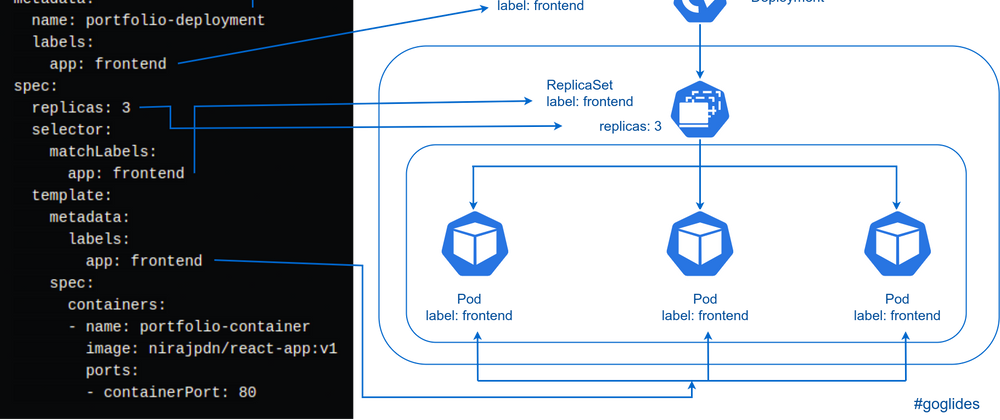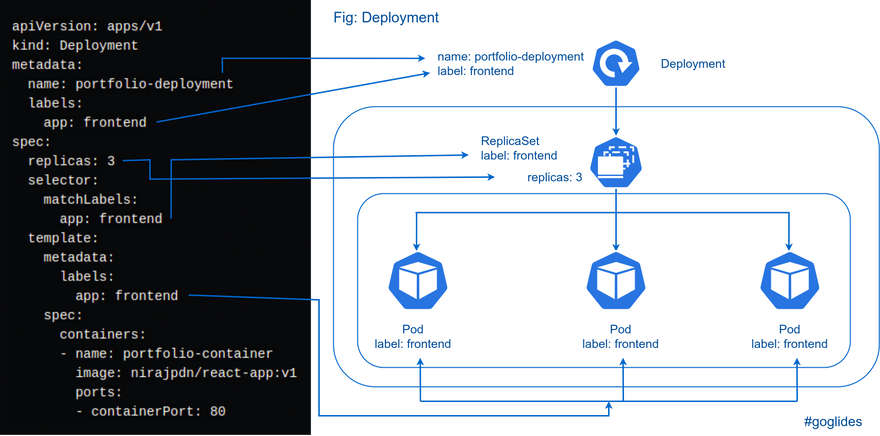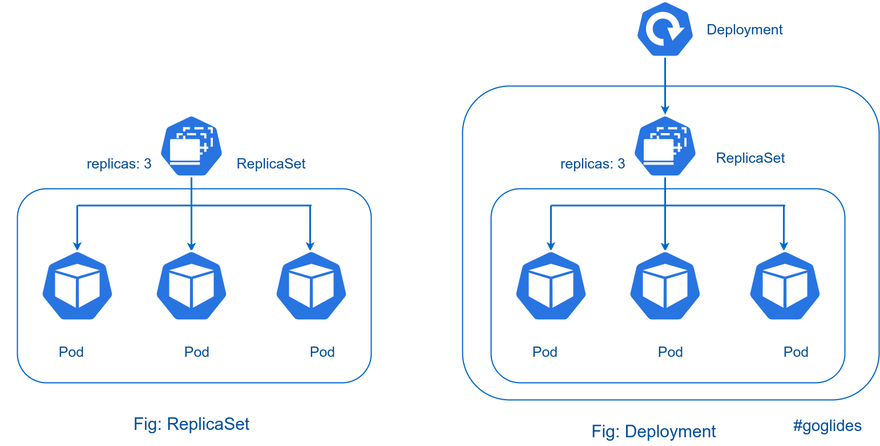In the previous post, we have discussed about ReplicaSet, how it is used to manage, create multiple instances of Pod.
Deployment
Deployment is a kubernetes object that is used to manage, organize, combine pods. When deployment is created, then it creates replicaset. Replicaset create pods according to the number specified in the replicas option.
Deployments are used to scale our application by increasing the number of running pods or update the running application.
Create deployment object
We can create deployment object in two ways:
Method 1: Using manifest file (yaml)
~ vim deployment.yaml
apiVersion: apps/v1
kind: Deployment
metadata:
name: portfolio-deployment
labels:
app: frontend
spec:
replicas: 3
selector:
matchLabels:
app: frontend
template:
metadata:
labels:
app: frontend
spec:
containers:
- name: portfolio-container
image: nirajpdn/react-app:v1
ports:
- containerPort: 80
Lets apply above file to create deployment,
~ kubectl apply -f deployment.yaml
deployment.apps/portfolio-deployment created
or
~ kubectl create -f deployment.yaml
deployment.apps/portfolio-deployment created
To view deployments in kubernetes cluster,
~ kubectl get deployment
Output
NAME READY UP-TO-DATE AVAILABLE AGE
portfolio-deployment 3/3 3 3 81s
Above output shows that, 3 instances of pods are deployed.
Lets check those Pods,
~ kubectl get pods --show-labels
NAME READY STATUS RESTARTS AGE LABELS
portfolio-deployment-67746bf69d-9njm5 1/1 Running 0 113s app=frontend,pod-template-hash=67746bf69d
portfolio-deployment-67746bf69d-wkqsq 1/1 Running 0 113s app=frontend,pod-template-hash=67746bf69d
portfolio-deployment-67746bf69d-zdvkt 1/1 Running 0 113s app=frontend,pod-template-hash=67746bf69d
As we have seen that, pods with label app:frontend and pod-template-hash=67746bf69d. pod-template-hash is added automatically by deployment controller.
Pods are associated with deployment and replicaset with the help of labels as shown in the figure below:
Do you notice Deployment and ReplicaSet have almost similar scripts in manifest file and what's the actual difference and why we need deployment object ?
ReplicaSet Vs Deployment
ReplicaSet ensures the number of running pods in the cluster. Pods are the replicas and the mechanism of specifying the number of running pods in the cluster. Changing the ReplicaSet will not have any effect in existing Pods. So it is not easy to change image version in the container.
Deployment is a higher-level abstraction that manages one or more ReplicaSet to provide controlled rollout of a new version. When image version is changed in Deployment, a new ReplicSet is new version will be created with initially zero replicas. Then it will be scaled up, after that is running the old ReplicaSet will be scaled down.
- Deployment resource make it easier for updating pods to new version.
- Deployment doesn't directly interact with Pods but it does rolling out update using ReplicaSets.
Lets update the version of image from nirajpdn/react-app:v1 to nirajpdn/react-app:v2.
You can describe the pod to know the current version of image used with command kubectl describe pods <pod-name>.
~ kubectl describe pods portfolio-deployment-67746bf69d-9njm5
Or just view the deployments with current image and container,
~ kubectl get deployments -o wide
Output
NAME READY UP-TO-DATE AVAILABLE AGE CONTAINERS IMAGES SELECTOR
portfolio-deployment 3/3 3 3 90m portfolio-container nirajpdn/react-app:v1 app=frontend
After that lets update manifest file,
apiVersion: apps/v1
kind: Deployment
metadata:
name: portfolio-deployment
labels:
app: frontend
spec:
replicas: 3
selector:
matchLabels:
app: frontend
template:
metadata:
labels:
app: frontend
spec:
containers:
- name: portfolio-container
image: nirajpdn/react-app:v2
ports:
- containerPort: 80
Lets apply above file to create deployment,
~ kubectl apply -f deployment.yaml
deployment.apps/portfolio-deployment created
NAME READY STATUS RESTARTS AGE
portfolio-deployment-67746bf69d-9njm5 1/1 Running 0 94m
portfolio-deployment-67746bf69d-wkqsq 1/1 Running 0 94m
portfolio-deployment-67746bf69d-zdvkt 1/1 Running 0 94m
portfolio-deployment-7f67bddbc5-wh5w6 0/1 ContainerCreating 0 8s
Here we can see, new instance of Pod is creating. After it is running, the new ReplicaSet with new version is scaled up and old ReplicaSet is scaled down.
Lets check Pods again,
NAME READY STATUS RESTARTS AGE
portfolio-deployment-7f67bddbc5-lnvxf 1/1 Running 0 18s
portfolio-deployment-7f67bddbc5-rcr6b 1/1 Running 0 21s
portfolio-deployment-7f67bddbc5-wh5w6 1/1 Running 0 99s
We have successfully updated the pods with new version of image. We can describe the new pod again.
~ kubectl describe pods portfolio-deployment-7f67bddbc5-lnvxf
Output
Name: portfolio-deployment-7f67bddbc5-lnvxf
Namespace: default
Priority: 0
Node: minikube/192.168.49.2
Start Time: Fri, 24 Jun 2022 10:21:14 +0545
Labels: app=frontend
pod-template-hash=7f67bddbc5
Annotations: <none>
Status: Running
IP: 172.17.0.14
IPs:
IP: 172.17.0.14
Controlled By: ReplicaSet/portfolio-deployment-7f67bddbc5
Containers:
portfolio-container:
Container ID: docker://fe23f5b33ba9593bf9c3f31cdf984856bb57edbabe9d70249a3bd3125d5e4fbc
Image: nirajpdn/react-app:v2
Image ID: docker-pullable://nirajpdn/react-app@sha256:c4352340615dd6d2f4df28c66d8e1ec23fd30588bf2b8ca405c369b3f6e05b66
Port: 80/TCP
Host Port: 0/TCP
State: Running
Started: Fri, 24 Jun 2022 10:21:16 +0545
Ready: True
Restart Count: 0
Environment: <none>
Mounts:
/var/run/secrets/kubernetes.io/serviceaccount from kube-api-access-hpr4m (ro)
Conditions:
Type Status
Initialized True
Ready True
ContainersReady True
PodScheduled True
Volumes:
kube-api-access-hpr4m:
Type: Projected (a volume that contains injected data from multiple sources)
TokenExpirationSeconds: 3607
ConfigMapName: kube-root-ca.crt
ConfigMapOptional: <nil>
DownwardAPI: true
QoS Class: BestEffort
Node-Selectors: <none>
Tolerations: node.kubernetes.io/not-ready:NoExecute op=Exists for 300s
node.kubernetes.io/unreachable:NoExecute op=Exists for 300s
Events:
Type Reason Age From Message
---- ------ ---- ---- -------
Normal Scheduled 5m35s default-scheduler Successfully assigned default/portfolio-deployment-7f67bddbc5-lnvxf to minikube
Normal Pulled 5m33s kubelet Container image "nirajpdn/react-app:v2" already present on machine
Normal Created 5m33s kubelet Created container portfolio-container
Normal Started 5m33s kubelet Started container portfolio-container
And this is why deployment object is needed to scale, manage, upgrade the pods as per our requirement.
Method 2: Using CLI
We can create deployment with command kubectl create deployment <deployment-name> --image=<image>
~ kubectl create deployment portfolio-deployment-cli --image=nirajpdn/react-app:v1
deployment.apps/portfolio-deployment-cli created
View Deployments
~ kubectl get deployments
NAME READY UP-TO-DATE AVAILABLE AGE
portfolio-deployment-cli 1/1 1 1 18s
portfolio-deployment 3/3 3 3 109m
By default, one instance of Pod is created.
Scaling application
~ kubectl scale deployment/portfolio-deployment-cli --replicas=3
deployment.apps/portfolio-deployment-cli scaled
Lets check,
~ kubectl get deployments -o wide
Output
NAME READY UP-TO-DATE AVAILABLE AGE CONTAINERS IMAGES SELECTOR
portfolio-deployment 3/3 3 3 124m portfolio-container nirajpdn/react-app:v2 app=frontend
portfolio-deployment-cli 3/3 3 3 8m20s react-app nirajpdn/react-app:v1 app=portfolio-deployment-cli
Lets update the image with CLI
We can update image version with command: kubectl set image deployment/<deployment-name> <container-name>=<image>
kubectl set image deployment/portfolio-deployment-cli react-app=nirajpdn/react-app:v2
Lets check deployment again,
~ kubectl get deployments -o wide
Output
NAME READY UP-TO-DATE AVAILABLE AGE CONTAINERS IMAGES SELECTOR
portfolio-deployment 3/3 3 3 132m portfolio-container nirajpdn/react-app:v2 app=frontend
portfolio-deployment-cli 3/3 3 3 15m react-app nirajpdn/react-app:v2 app=portfolio-deployment-cli
Delete deployment
We can delete deployment as follows:
~ kubectl delete deployment/portfolio-deployment-cli
deployment.apps "portfolio-deployment-cli" deleted
Lets confirm,
~ kubectl get deployments
Output
NAME READY UP-TO-DATE AVAILABLE AGE
portfolio-deployment 3/3 3 3 139m
Alright, this much for deployment object of kubernetes in this post.






Top comments (0)